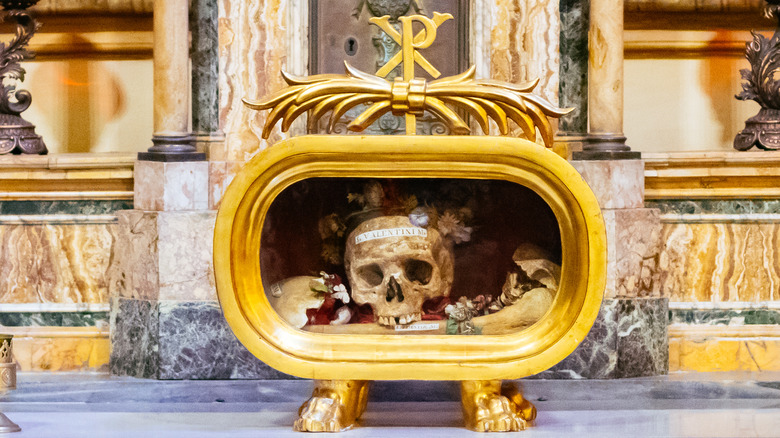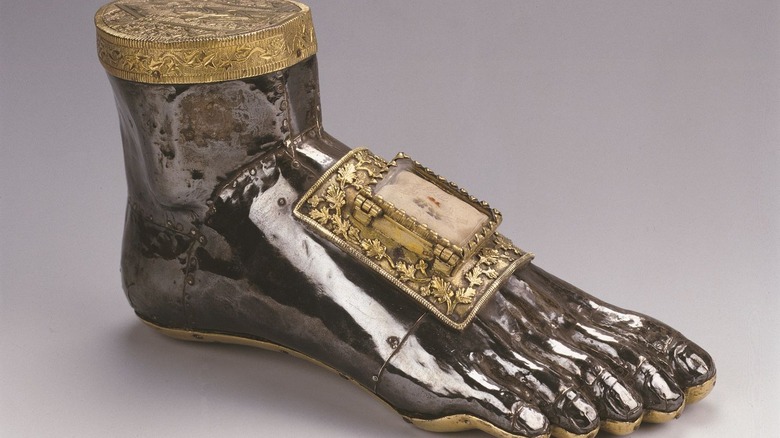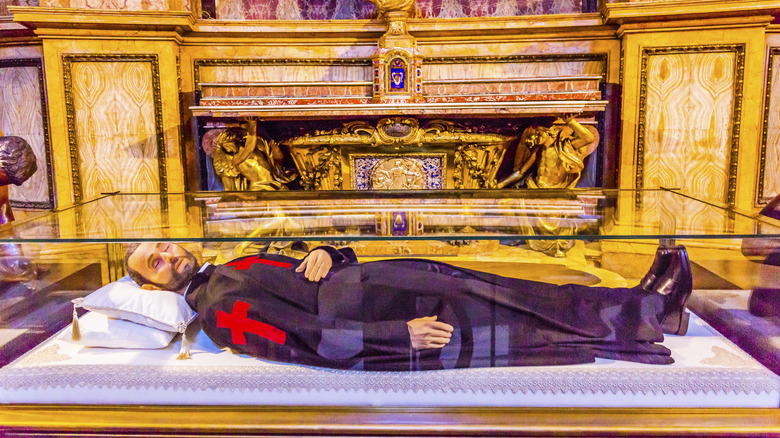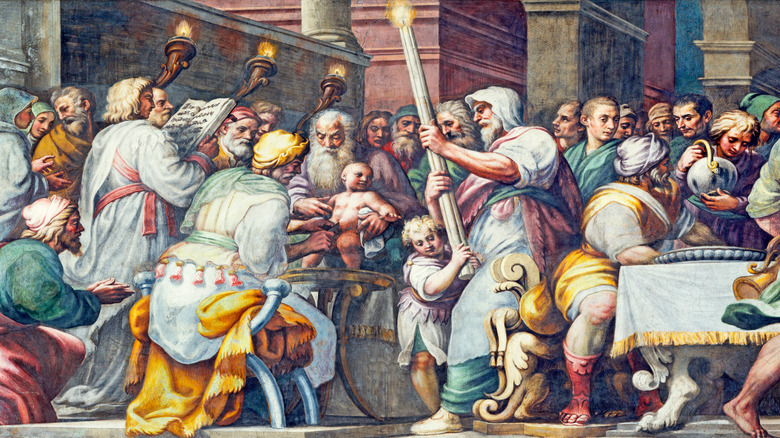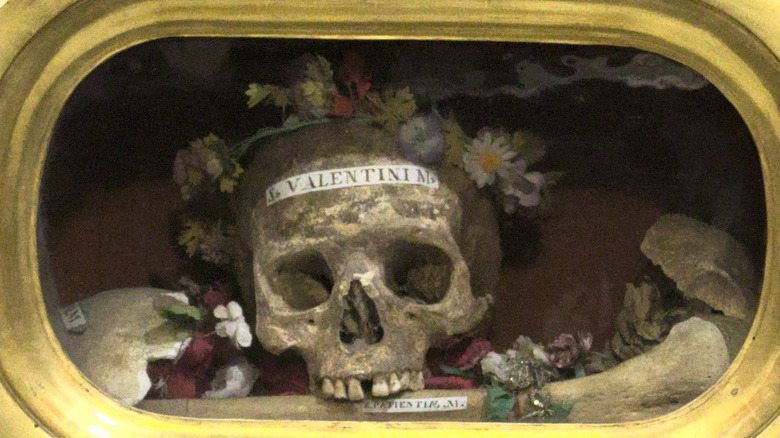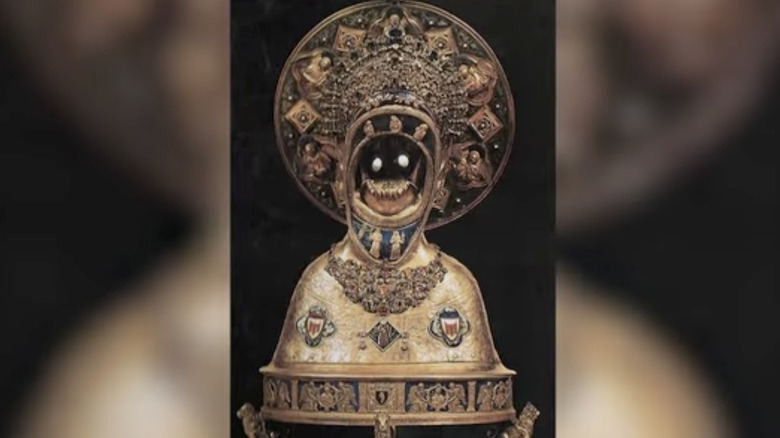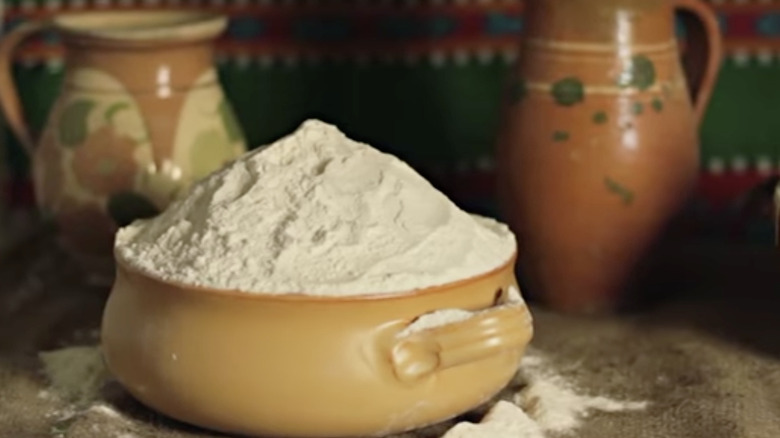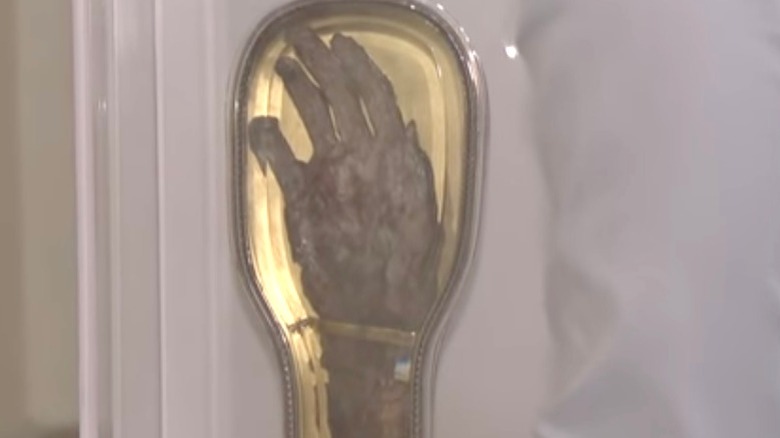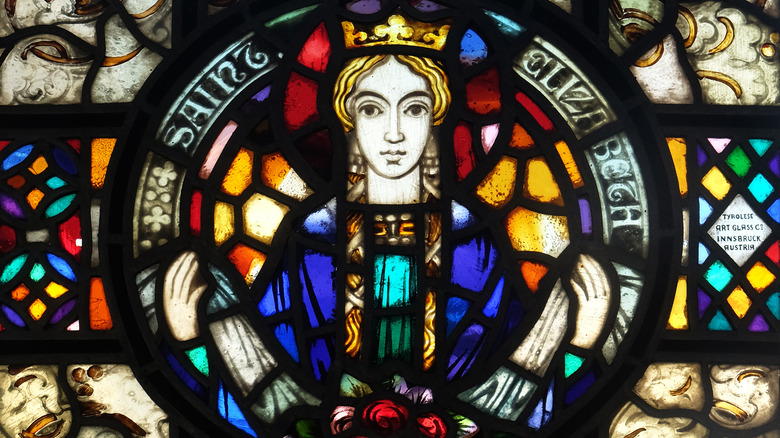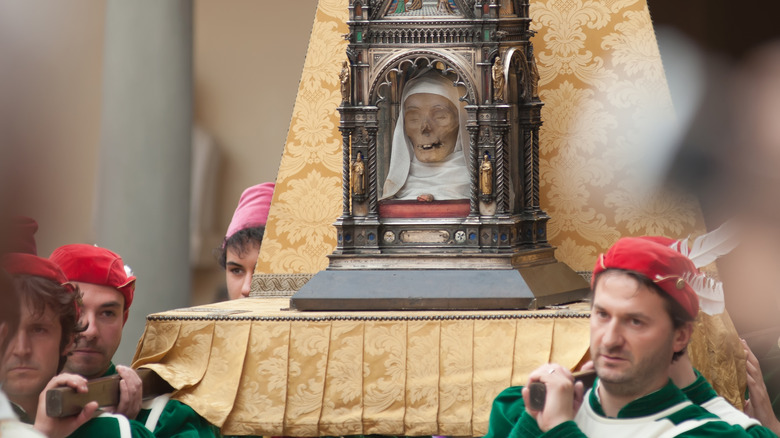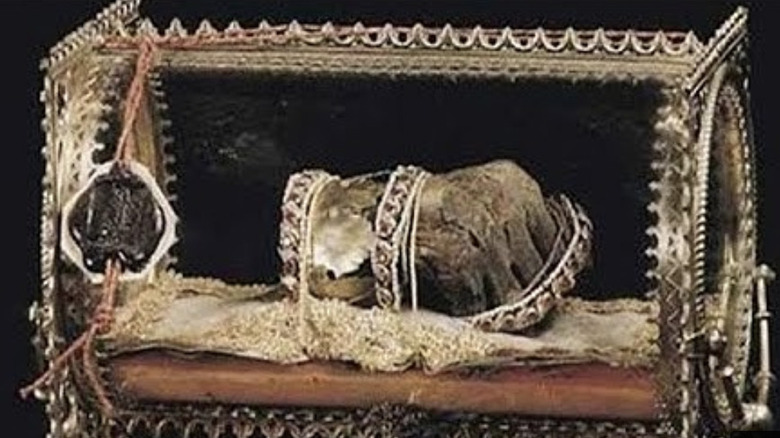History Of The World's Most Macabre Catholic Relics Explained
The Catholic church claims to be the original Christian church founded by the Apostle Peter after the death and resurrection of Jesus of Nazareth (via "Saint Peter and the Papacy"). That's a 2,000-year-old history and one the church doesn't take lightly. Not only have Church leaders kept copious records over the millennia, but they've also played the part of religious hoarders, stashing away a little bit of everything. Especially when it comes to relics attributed to saints.
From withered hands to portions of mummified feet and jerkied hearts, these sacred objects can be off-putting. In "The Innocents Abroad," humorist Mark Twain comedically observed he'd seen enough of Saint Denis' bones in European cathedrals to "duplicate him if necessary." And as for nails from the Cross, he hypothesized you could fill a keg with them. For non-Catholics like Twain (and less traditional Catholics alike), these ancient vestiges of age-old tradition look like superstition at its most gruesome.
They beg the question: Why keep such macabre items? In "African Pentecostals in Catholic Europe: The Politics of Presence in the Twenty-First Century," author Annalisa Butticci explains, "To Roman Catholics, relics are a source of divine power, as well as vehicles of the creation and circulation of social memory ... a source of considerable honor and pride." A couple of centuries ago, they also represented tourist attractions, drawing pilgrims from the four corners of the globe. Here's what you need to know about the world's most macabre Catholic relics and where to find them.
Saint Blaise's feet
Most people use their feet for walking. But Saint Blaise had little use for them after martyrdom in 316 A.D. (via the Christian History Institute). Before beheading him, executioners tore the flesh from his body using "wool combers' irons," according to Britannica. But death couldn't extinguish the renown he'd gained during his lifetime as a faithful follower of Christ and performer of miracles. He would go on to sainthood in the Oriental Orthodox, Eastern Orthodox, and Roman Catholic churches, which meant selecting choice body parts for preservation as relics.
When a plague broke out in the streets of Ragusa (now Dubrovnik) in 1346 A.D., church leaders recovered Saint Blaise's relics and transported them to the city, making him patron saint. These relics included one of those previously mentioned trotters, along with his right hand, throat, and head. City fathers built a church in his honor, a public demonstration of gratefulness for the saint's miraculous post-mortem intervention during the Black Death. Today, Blaise's foot remains a staple attraction of the city, housed in a "boot-like gold and silver case," per James Stewart's "Top 10: Dubrovnik and the Dalmatian Coast."
As for Blaise's other foot, seeing it requires a trip to Belgium's Museum of Ancient Arts in Namur. According to Rachel Brown and Bruce Holsinger's "History in the Comic Mode: Medieval Communities and the Matter of Person," this tootsie ended up in a foot-shaped metal reliquary specially designed in the workshop of Hugh of Oignies around 1260 A.D.
Saint Camillus de Lellis' heart
Saint Camillus de Lellis started out as a professional gambler and soldier (via Britannica). By 1575, he converted to Catholicism, dedicating his life to serving others. He worked at St. James' Hospital, a Roman facility for "incurables." (De Lellis had been a patient there after his leg developed an erupting ulcer, an excruciating lifelong condition.)
To seal the Catholic deal, he became an ordained priest in 1584. Two years later, the pope approved the priestly congregation he founded. This organization, known as the Ministers of the Sick, dedicated themselves to serving the hospitalized. To distinguish the 12 members of the group, they wore red crosses on their religious garb. When de Lellis died in 1614, the Ministers of the Sick had ballooned to almost 300 members, and he'd earned a reputation for laboring in the faith despite facing profound health issues.
His followers made a case for potential sainthood, granted with his canonization in 1746. His preserved heart soon took on another life as a relic. Nowadays, it circles the globe "inspiring" the faithful with its macabre appearance. The preserved heart's travels have included Ireland (via the Orders of St. Camillus) and the Philippines (via Robert Lim's Catholic Voice Media). It's also made the rounds in Vietnam and Thailand, according to San Camillo de Lellis. Last but not least, it proved a hit in Brazil, per Annalisa Butticci's "African Pentecostals in Catholic Europe."
Jesus of Nazareth's foreskin
To say that controversy surrounds the alleged foreskin of Jesus is an understatement, per Wired. Known as the holy foreskin or the holy prepuce, this leftover from the Messiah boasted hyper-incorruptibility, per CBC Radio Canada. Incorruptibility refers to supernatural preservation of saintly flesh. In the case of Jesus Christ, believers in the Middle Ages assumed his incorruptibility even greater than mere saints. So, the faithful never doubted the ability of the infant's foreskin to survive for hundreds or even thousands of years.
However, Jesus' foreskin seemed to have the curious ability to reproduce. More than 12 churches in western Europe claimed ownership of it during medieval times, undoubtedly leading to confusion for on-the-go pilgrims. Since relics made up the bulk of the tourist trade, it's easy to see where the temptation came from. Think of the draw the only physical remnant of the Savior following the Ascension brought!
Wired tells us the holy prepuce (and its 11 imposters) disappeared for 1,500 years. Eventually, it resurfaced in Calcata, Italy, throwing shade at Leo Allatius. (A 17th-century theologian, Allatius claimed the Lord's foreskin floated into the heavenlies, becoming Saturn's famous rings.) Soon, stories abounded about the many miracles attributed to the bit of flesh in Calcata. But then another supposed foreskin showed up in France in 1900. Awkward, to say the least. So, the Catholic church declared the relic a taboo, threatening to excommunicate anyone who breathed a word about it. It's been radio silence ever since.
Saint Valentine's skull
In the Basilica di Santa Maria in Cosmedin, you'll find a skull decorated with a sentimental spray of dried flowers, as reported by Atlas Obscura. Across the forehead, hand-painted lettering identifies it as none other than Saint Valentine's head. Like Saint Patrick, Valentine remains one of the most universally popular saints both inside and outside the Catholic church. As the holy guardian of lovers, the poesy-decorated relic remains one of the most romantic to be found in a Roman reliquary.
But like Jesus' foreskin, Atlas Obscura also notes the skull suffers from identity issues. For starters, the Basilica di Santa Maria is but one of 10 places claiming to house Saint Valentine's mortal remains. From Glasgow to Dublin, Prague to Florissant, Missouri, plenty of places claim to have him. This makes authentication tricky. Add to this, the faith boasts two Saint Valentines separated by approximately 1,500 years, and identifying his remains gets even tougher.
Besides being the emblematic saint of lovers, Saint Valentine also has associations with epileptics, the plague, and beekeepers. Beyond this, the church knows surprisingly little about the man's real life. But as early as the fifth century, February 14th had become a day set apart to commemorate him. Although Saint Valentine has more heads than ever, thanks to overzealous relic hunters of the past, he continues to inspire the celebration of love. And there's something darkly alluring about his Italian-based, bloom-covered, defleshed noggin. (Maybe that's just the emo in us talking.)
Saint Anthony's tongue
Saint Anthony gained renown for his divine oratory skills, according to Atlas Obscura. Born in 1195 in Lisbon, Portugal, he left it all behind to join the Augustinian order at 15, as reported by Indian Catholic Matters. Eventually, he made his way to Saint Francis of Assisi's congregation. Not one to brag, he kept his fantastic speaking skills under wraps until asked to fill in for another speaker last minute. He blew everyone away.
After death in 1231 A.D., followers interred his body at the Church of Saint Mary in Padua, Italy, per Dr. Taylor Marshall. 30 years after his death, devoted followers exhumed his body to move it to a basilica. Not surprisingly, his body had succumbed to decomposition ... except for his tongue. Curiously, it remained moist and supple. This sounds like the premise for the next Tom Cruise "Mummy" movie. But the sight of the wet, juicy member signaled one thing to medieval thinkers — saintly incorruptibility.
These days, don't expect Saint Anthony's tongue to look particularly appealing (or do a lot of wagging). Adjectives like "desiccated" and "ancient" better suit it. Presented in his skeletal lower jaw, it's an acquired taste. As for the gaudy, golden reliquary holding the body parts, it's impressive if you're into that type of thing. Nevertheless, Anthony's palate still draws pilgrims. One of the big reasons for the attraction is Anthony's reputation as the patron saint of vanished items. For the faithful, there's no better car key locator.
The Virgin Mary's breastmilk
Pope Francis made waves in 2018 when he declared breastfeeding "the language of love" and openly invited mothers to feed their children in the Sistine Chapel, per National Public Radio (NPR). While contemporary people remain split today about their comfort levels with public breastfeeding, things were different in the Middle Ages.
Back then, everybody got behind it. Even church officials like Saint Bernard who claimed the Virgin Mary breastfed him in a religious vision (via Cambridge University Press). Let that soak in for a moment. There are famous artistic depictions of the event, known matter-of-factly as "Saint Bernard's Lactation." Flemish art infuses the whole scenario with a certain eroticism, between the Virgin Mary's naked breast and milk streaming from it. Some depictions even show the breastmilk transforming into light rays as if bridging the gap between the physical and spiritual.
With all this bizarre focus on the Madonna's breast milk, it's no wonder one of the most famous relics in Israel remains her breastmilk. Visitors to Bethlehem often tour the Milk Grotto, a cave allegedly transformed from red rock to pure white through contact with drops of Mary's breastmilk (via BBC). Believers say the cave contains healing powers, and many people have claimed miracles at the site. Infertile women say consuming the cave's white powder in a beverage leads to children. So, the nuns who maintain the site sell conveniently-sized sachets of the stuff to tourists.
Saint Francis Xavier's arm
With Saint Francis Xavier, nothing better sums up his life and works than his arm, per "The Corpse: A History" by Christine Quigley. During his lifetime, church officials claim he baptized 100,000 individuals with that arm. So, preserving it proved vitally important to his followers. And they did a decent enough job. Tourists still flock to the withered member, and it makes trips all over the world.
Writing for America: The Jesuit Review, John O. Brien, S.J., recollects seeing the saint's 465-year-old limb for the first time in a Holiday Inn's lobby. The arm was on a whirlwind tour of Canada, and O'Brien described the multi-layered way it traveled in a heavy-duty reliquary housed within plexiglass and then carried in a tote-case of canvas. Despite these modern accouterments, O'Brien wrote, "The sense of the ancient and the sacred struck me viscerally."
O'Brien also expressed concern about how a western nation known for its secularist bent would receive the relic. Genuinely surprised by the enthusiastic reception the body part heralded, he came away feeling as if the saint still managed to exude a conciliatory presence, uniting believers with a stronger sense of faith. It's hard to get into the relic-chasing mindset if it falls outside of your cultural norms. But perhaps O'Brien's explanation is among the best when trying to explain the attraction of these highly sacred and uncomfortably macabre objects today.
Elizabeth of Thuringia's nipples
Elizabeth of Thuringia set herself apart with her devout and penitential ways, per Church Times. Today, we'd call the self-imposed punishment she endured downright masochistic. But times were different back in the 13th century. Widowed at 20 after her husband Louis IV, Landgrave of Thuringia's battlefield death in the Crusades, she came under the spell of the cult-like leader Conrad of Marburg.
Within four years, Elizabeth of Thuringia lay dead, killed by the excessive cruelty of Marburg. But people proved too impressed by her sacrificial existence to express public outrage against her cruel counselor. As the daughter of the King of Hungary and a noted Christian devotee, her body lay in state for four days. Reports soon circulated that her corpse gave off a pleasant odor that "seemed to warm the spirit," according to eyewitness accounts translated in "The Life and Afterlife of St. Elizabeth of Hungary."
Soon, mourners ravaged her corpse, bent on preserving a little piece of the saintly lady. These so-called devotees tore pieces from her clothing, cut off her hair and nails, and even took blades to her ears and nipples in some of the most dreadful relic-hunting in history (via the Catholic Historical Review). After the literal body harvesting, reports of miracles spread throughout the area like wildfire, Eamon Duffy writes in "Royal Books and Holy Bones: Essays in Medieval Christianity."
Saint Catherine of Siena's head
Catherine of Siena gained renown for her "mystical marriage" to Christ, per "Holy Feast and Holy Fast: The Religious Significance of Food to Medieval Woman" by Caroline Bynum. Catherine claimed she wore an invisible ring of her bridegroom's foreskin, devoting herself to the care of the poor. (For those of you who are counting, the official Jesus foreskin tally stands at 14, counting the rings of Saturn.) According to Atlas Obscura, nobody else could see the engagement ring but her. (No surprise there!)
Catherine of Siena led a life of great deprivation, which likely contributed to her demise at 33. During her lifetime, she claimed to have received the stigmata, which meant she bled from her hands, feet, and heart, mirroring the wounds of the crucified Christ. And it gets a whole lot weirder from there. Eyewitnesses claim she levitated while praying. But perhaps the most convenient miracle attributed to her involved communion. According to one priest, she didn't even have to approach the altar for the wine and bread. Instead, it supernaturally flew from his hands to her lips.
Despite marriage to the Messiah, death wrecked her corpse. But she had one thing going for her, a mummified head viewable today at the Saint Dominic Basilica in Siena, Italy. Housed in an elaborate reliquary, it remains tucked behind bars to deter would-be head thieves. Nearby, her desiccated right thumb has set up shop in a miniature shrine.
Saint Stephen's hand
You've likely figured out that there was a whole lot of exhumation going on when it came to prominent Catholic burials. Maybe they never heard of the whole "Rest in Peace" thing. Take, for example, the tale of Saint Stephen, Hungary's first king, per Hungarian Spectrum. After dying in 1038 A.D., his followers raised his body and moved it. Ironically enough, the reason for pulling his corpse was a desire to prevent "disturbances of the grave." Ha!
To the surprise of those relocating his corpse, Stephen's hand remained well-preserved. (Can we really call this a surprise?) Of course, once the miraculous member saw the light of day, church officials felt compelled to put it on display. Supernatural healings quickly followed, inspiring the man who guarded it to steal the relic. (It'd be nice to ask Dante what level of hell he reserved for that guy.)
Fortunately, church officials eventually found the hand and reunited it with the basilica. Despite wars and Turkish occupation, Saint Stephen's member remained safe and intact, and you can still see it on display. But a variety of inconsistencies point to the fact it may not be Stephen's hand after all. These include lack of a royal insignia ring or evidence it ever wore one. The current tight-fisted hand also deviates from early depictions of the original, which appeared on the coat-of-arms of the town of Szentjobb. That depiction shows an open-handed member preserved to the elbow.
Saint Agatha's breasts
As Father Carota explains in Traditional Catholic Priest, Catholicism has always emphasized principles such as modesty, especially among female devotees. He links it directly to the level of respect women show for the Savior through the various steps of the Blessed Sacrament (e.g., baptisms, weddings, mass, etc.). But when it comes to the holy relics of saints, all bets are off.
For example, there are relics like the breasts of Saint Agatha. They got removed with shears of iron to punish her for rejecting the sexual advances of a Roman official, Governor Quintiamus (via Contemporary OB/GYN). From there, the tortured young woman went to prison where she received a visitation from the Apostle Peter, as reported by Britannica. According to legend, Peter comforted and prayed with the young woman, healing her grave injuries. Not bowled over by this miracle, her prison-keepers attempted to burn her at the stake. This time, the plan failed due to divine intervention. An earthquake occurred at the moment the flames of her pyre got lit, inspiring the people to beg for an end to her tortures. Tradition says she eventually perished in prison.
Her breasts remain in an effigy brought out three times each year for display in Catania, Sicily, according to "The Corpse: A History." And Sicilians still celebrate her sacrifice in other ways. Local tradition includes baking breast-shaped marzipan and ricotta pastries, complete with cherry nipples on top, as reported by Atlas Obscura.
